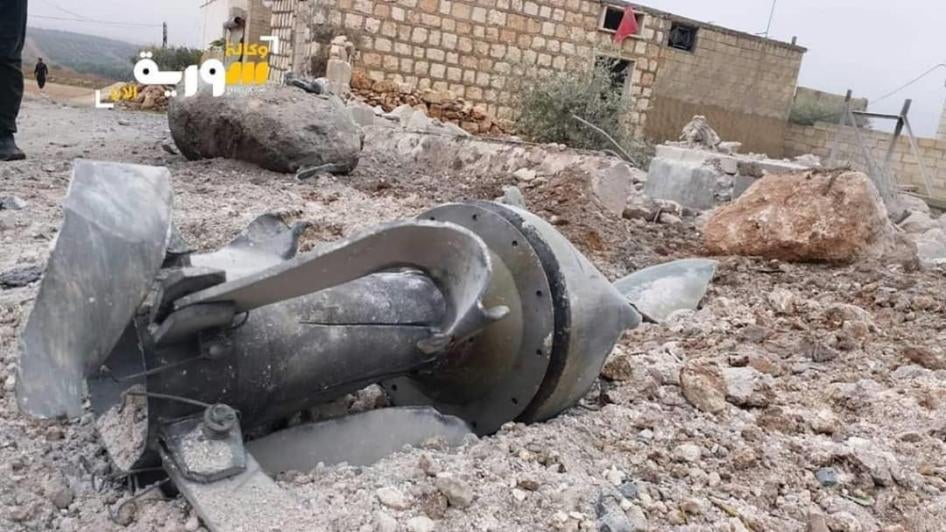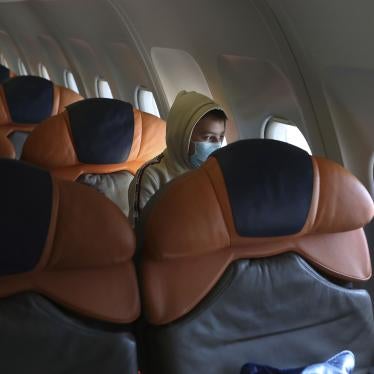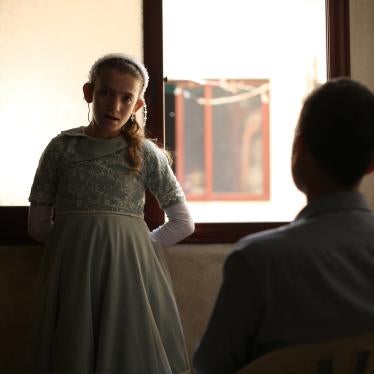(Beirut) – A November 24, 2018 attack by Syrian government forces near an elementary school that killed six children, a teacher, and a student’s mother, appears to have been unlawful and indiscriminate. All parties to the conflict, including the Syrian-Russian military alliance and non-state armed groups, should ensure that children and civilians are protected from any attack.
The ground-launched attack in the town of Jarjanaz, in Idlib governorate, was with a Russian-made 240mm mortar system, which fires a large high-explosive projectile that is designed to “demolish fortifications and fieldworks,” according to a Russian arms merchandizing catalogue. It also wounded as many as 10 children, at least two of whom lost limbs, and three adults. Launching an indiscriminate attack resulting in death or injury to civilians, or an attack in the knowledge that it will cause excessive incidental civilian loss, injury or damage, when committed with criminal intent, can amount to a war crime.
“This horrific attack on Jarjanaz is a small glimpse of what an all-out offensive on Idlib without strict measures to protect civilians could mean for thousands of children,” said Bill Van Esveld, senior children’s rights researcher at Human Rights Watch. “In light of recent upheavals in the province, it is essential for Russia to pressure Syrian government forces to halt such blatantly unlawful attacks and for all parties to the conflict to make protecting civilians a priority.”
About 3 million people remain in Idlib, over half of whom have fled fighting elsewhere in Syria. It is one of the last major areas controlled by anti-government groups. Despite a ceasefire agreement between government and anti-government armed groups in Idlib governorate since September 17, both parties have carried out artillery attacks. In November and December, there were at least eight attacks on Jarjanaz, which residents say was under the control of the Turkey-backed anti-government National Liberation Front at the time of the November 24 attack. In January, the area was taken by Hay’et Tahrir al-Sham, an anti-government group known to be close to al-Qaeda. In-fighting among the anti-government factions has also caused civilian casualties.
Witnesses said that between 12:45 and 1 p.m. on November 24, three projectiles hit the area near al-Khansaa elementary school, on the southwestern outskirts of Jarjanaz, causing massive explosions. Photographs shared with Human Rights Watch by witnesses and online videos posted within hours of the attack show remnants of Russian-made 3F2 “Gagara” rocket-assisted 240mm mortar projectiles.
Al-Khansaa elementary school operated with two shifts, the first for children ages 6 to 9 and the second, which began at 11 a.m., for children ages 8 to 13, school administrators said. Roughly 200 children in the second shift were at the school when the first artillery round exploded at around 12:45 or 12:50 p.m. on Saturday, a school-day in the area, school officials told Human Rights Watch.
Next to the school is a teacher-training college with another 250 students, attended by women ages 19 and older. All remained inside the college during the attacks and none were wounded, said school officials and a civil defense volunteer whose father works at the college.
Human Rights Watch spoke via WhatsApp with seven witnesses to the attack, including three staff members at the school, a store-owner who lives nearby, a local media activist, and two civil defense volunteers who arrived at the school to evacuate the wounded. All asked not to be named, fearing reprisals by government forces. Human Rights Watch also reviewed photographs and videos the witnesses shared, and videos and images of the attack posted online.
Witnesses said they could not hear the mortars being fired but that the explosions were extraordinarily loud, which is consistent with the range and destructive power of rocket-assisted 240mm mortar projectiles. “The sound was louder than barrels or MiG bombs,” one resident said, referring to the improvised barrel bombs, dropped by Syrian helicopters and to conventional high-explosive bombs dropped by fixed-wing Russian-made aircraft.
All the witnesses Human Rights Watch interviewed affirmed that no military objects were in Jarjanaz or near the school, although Human Rights Watch could not independently verify this. A media activist said that residents had not permitted “armed groups to cross through [Jarjanaz], no convoys, and there are no military headquarters. The headquarters are in agricultural lands far away from the town.” A school official affirmed that “there have been no military centers or headquarters in Jarjanaz” since the conflict began in 2011.
The lack of a military presence in or near the school, or the surrounding area would make such attacks on civilians indiscriminate and possibly deliberate. Even if the attacks had targeted a military objective, the use of explosive weapons with wide-area effects in a populated area should be avoided due to the foreseeable harm to civilians, Human Rights Watch said.
“There is no excuse for attacking civilian structures like schools, yet Syrian forces continue to maim and kill schoolchildren with impunity,” said Van Esveld. “Stopping indiscriminate attacks is an important first step to protect those most vulnerable.”
The Weapons Used
The rocket-assisted mortar projectiles used in the attack have a maximum range of up to 20 kilometers, with a high-explosive warhead weighing 46 kilograms with wide area destructive effect. Each projectile weighs 239 kilograms and requires a team of at least five to load and fire from 240mm mortars that are either towed or mounted on a carrier vehicle.
Human Rights Watch documented the Syrian military’s devastating use of 240mm mortars in indiscriminate attacks on the city of Homs in 2012, and the use of a rocket-assisted 240mm cluster munition projectile containing submunitions in an attack on a school in the Damascus suburb of Douma in 2015. None of the armed opposition groups in Syria are known to have used the 240mm mortar system.
The November 24 Attack
The first projectile landed about 550 meters northeast of the school, destroying a four-room house whose owners were not home. About eight minutes later, the second projectile exploded in the street about 30 meters northwest of the school, killing Rawea Abdel Rezzek al-Dugheim, 30, and her son, Hussein, 11, a student, who were in a car. Staff members said the blast shattered school windows and that several panicked students and a teacher who lived nearby ran out of the school to adjacent agricultural fields.
Two or three minutes after the second explosion, the third projectile hit the same agricultural area, about 75 meters west of the school, two school officials said, killing the teacher, Khadija al-Dabaan, age 30 or 33, who was pregnant; brothers Iyad and Abdelghani al-Dugheim, 10 and 11; Othman Ahmad al-Dabaan, 9; and two girls, Nijmeh al-Dabaan, 12, and Asmaa al-Khattab, 12, who had run out of the school.
The third attack wounded 10 children, of whom 9 were students, according to residents and rights monitors, including the teacher’s 20-month-old son, whom she was carrying and whose left leg was cut off; a 10-year-old boy whose right leg was cut off; another student; and a boy who was coming to bring his sister home from school; a woman who came to pick up her children; a 50-year-old resident, whose abdomen and spine were wounded, partially paralyzing him; and Maarouf Ibrahim al-Jabban, a civil defense volunteer, wounding his vertebrae and spine.
Attacks continued later that day, and the next. F.D., a media activist who filmed the attacks at the school in Jarjanaz, told Human Rights Watch that “there was shelling every two hours.” A 3-year-old girl, Amina al-Dibo, was killed by artillery shelling at 2:30 a.m., and her 5-month-old brother was wounded, residents and rights groups reported.
Two school officials said that they and many other residents had fled Jarjanaz due to the ongoing attacks. One school official said that the town was hit by more artillery attacks on November 25 and 26: “There is no one left. If there are no citizens and there are no students, who will open the schools?”
An attack on September 10 hit the al-Quds primary school and the adjacent al-Nidhal secondary school in Jarjanaz, wounding five students and causing the schools to close for three days, according to rights monitors and another school official, H.D. Residents said that another attack, on November 2, killed eight people, all civilians. Among the fatalities, Syrian rights monitors identified two children, Mustafa al-Khatoun, 15, and Mohammad al-Ezo, 10.
Witness Accounts
A senior school administrator, H.D., said that after the first attack, he stood at the main entrance to the school to try to prevent the children from leaving:
In training sessions, we’re told that staying inside [during an attack] is safer than being outside. At the same time, however, glass had shattered and people were fainting. Parents arrived to take their children, they were scared. And when they arrived, the second attack came. The second and third [rounds] hit barely a few meters away from the entrance. ... No day was like [November] 24. A father, a mother, they came to get their children, and to see them die in front of their eyes? A hundred meters apart, but they couldn’t reach each other. This is going to affect everyone in Jarjanaz, the entire education sector.
M. D., who owns a shop in the main market of Jarjanaz, said he began driving home on his motorcycle after the first explosion, and that his home was near the school, where the second explosion hit while he was on his way.
I arrived at the school entrance. Children were screaming -- mothers, all of them crying. Remains all over. An arm. A leg. Guts. You can’t describe it, some had lost a leg, some lost an arm, some were screaming. These is nothing more hideous. The first person I saw was my brother. He had been hiding behind a wall, but it was fate. He was hit by a [metal fragment]. It seems he was trying to head toward our home to hide, but he didn’t make it. He was in Grade 5. I went to him, removed his backpack, and carried him to a vehicle and they took him away.
I stayed to help the civil defense, and suddenly the third [projectile] fell, about 10 meters west, injuring a lot of people, including a guy from the civil defense. Whoever wasn’t hit in the second attack, was in the third. I don’t know what to say. It tears your heart apart. Children begging me, “Uncle please pull us out, we need help.”
F. D., the media activist, said he was “worried the school was targeted” after hearing the second attack, and drove toward the site.
Two minutes after the second, the third [shell] fell while I was on my way. The second one fell in the street, in front of a home, damaging it and destroying two vehicles. The civil defense arrived to rescue people and pull out the children, [whose bodies were] in pieces, with their backpacks. What I saw was horrible. On the right, people asking for help, crying. On the left, also, people asking for help. From the front, people crying and sobbing. I looked to the left and saw a vehicle that was destroyed with a woman and child killed. […]
The third [mortar projectile] had exploded] in a field and killed the students who had been running away from the school through the agricultural lands, as they were scared to run away in between the houses. One had no leg. Another lost half his head. Another one, part of him was gone. They were all torn apart and yet had their backpacks on their shoulders. Blood was all over the place. Artillery shelling. I felt lost. It was horrible. I’ve seen a lot. But similar to this, nothing.
M.J., a civil defense worker from the Talmenes center, drove to the school in a pickup truck accompanied by an emergency vehicle to evacuate casualties from the second projectile. He suffered a back injury from the blast wave from the third projectile:
When I got out of the pickup, I walked a few meters toward the place where the second [projectile] fell. When the third fell, the pressure, it threw me onto the truck. I remember there were two girls, students walking toward me. I hit the truck and fell down on the ground. The two girls fell down in front of me. I tried to pull one of them, barely got to her, but couldn’t due to my injury. My back, my leg, didn’t let me pull her. The girl died. I survived.
A.I., who works at the school, heard the first projectile detonate, but said the second explosion caused children to “start screaming”:
The sound of the explosion, it’s the first time we hear something like that, it was huge, very, very terrifying, and very harmful. We tried to control the situation. We put everyone in between two buildings. We closed the doors, we didn’t want to let them go outside. Some, however, left along with the teacher, and the second [projectile] fell where they were, 25 meters away. The school was the target.








